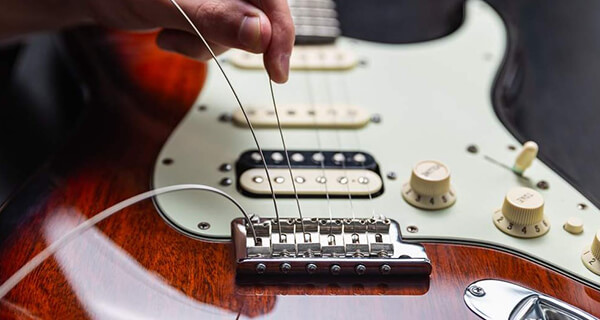Olive Oil on Fretboard [Way to Use]
In the realm of musical instrument maintenance, the fretboard stands as a vital interface between a musician’s fingers and the soulful melodies they bring to life. Yet, this integral component often remains overshadowed by its more prominent counterparts. Enter the unexpected hero of fretboard care: olive oil. In a world of specialized commercial products, the use of olive oil might seem unconventional.

But its potential benefits and natural properties make it a viable contender for nurturing the health and playability of your guitar. This guide unravels the mysteries surrounding the application of olive oil on fretboards, delving into its advantages and revealing the proper techniques for achieving harmonious results.
# Table of Contents =>
Benefits of Using Olive Oil on Fretboards –
a) Hydration and Conditioning:
Just as your skin needs moisturizing, so does your fretboard. Olive oil acts as a natural moisturizer that penetrates the wood, preventing it from drying out and cracking. This hydration not only maintains the aesthetics of the fretboard but also prevents potential structural damage.
b) Enhanced Aesthetics:
Applying olive oil to your fretboard can rejuvenate its appearance, giving it a rich, darker color. This can make your guitar look newer and more attractive.
c) Improved Playability:
A well-conditioned fretboard ensures smoother movement of your fingers across the strings, allowing for better playability. The natural oils in olive oil can reduce friction, enabling faster and more accurate playing.
d) Protection against Environmental Changes:
Wood is susceptible to changes in humidity and temperature, which can lead to warping or cracking. Olive oil’s moisture-retaining properties provide a barrier against these fluctuations, safeguarding your fretboard’s structural integrity.
Choosing the Right Olive Oil –

Not all olive oils are suitable for use on fretboards. Extra virgin olive oil, known for its purity and lack of additives, is the preferred choice. Avoid using flavored or infused oils, as they might contain substances that could damage the wood or leave unwanted residue.
a) Proper Application Steps:
Caring for your fretboard with olive oil involves a few simple yet crucial steps to ensure optimal results. Follow these steps to effectively apply olive oil to your guitar’s fretboard:
b) Gather Supplies:
Before you begin, gather the necessary supplies:
- Extra virgin olive oil
- Soft, lint-free cloth
- Small bowl
c) Prepare the Fretboard:
Loosen the guitar strings slightly to provide easy access to the fretboard. Lay the guitar on a stable surface, ensuring it’s securely supported to prevent any accidental movement.
d) Oil Application:
The process of applying olive oil to your guitar’s fretboard is a pivotal step in maintaining its health and enhancing its playability. To achieve optimal results, a systematic approach is crucial. Begin by preparing a small bowl of extra virgin olive oil, ensuring you don’t pour an excessive amount. Take a soft, lint-free cloth and fold it into a manageable size, dipping one corner into the bowl to absorb a modest quantity of oil.
Carefully and gently glide the oiled cloth along the entire length of the fretboard, paying attention to each fret and ensuring uniform coverage. The key is to apply a thin, even layer of oil, preventing buildup and residue. Allow the oil to rest on the fretboard for approximately 15 to 20 minutes, permitting the wood to absorb the moisturizing benefits.
Following this waiting period, transition to a clean, dry section of the cloth. With a gentle touch, delicately wipe away any excess oil from the fretboard’s surface. This step is vital in preventing the formation of a sticky surface that could compromise the playing experience.
Keep in mind that olive oil-soaked cloths can pose a fire risk, so ensure responsible disposal by allowing the cloth to dry flat in a well-ventilated area or consider submerging it in water before discarding.
By adhering to these meticulous oil application steps, you’re nurturing your fretboard’s longevity, aesthetics, and overall performance. This methodical care allows the wood to maintain its moisture, safeguarding it from the rigors of changing humidity levels and enhancing its resonance.
e) Wipe Excess Oil:
After the oil has had time to penetrate the wood, take a clean, dry section of the cloth. Gently wipe off any excess oil from the fretboard’s surface. This step is crucial to prevent the formation of a sticky residue.
f) Restring the Guitar:

With the excess oil removed, it’s time to restring your guitar. Carefully reattach and tune the strings to your desired pitch.
By following these proper application steps, you’ll effectively hydrate and enhance the appearance of your fretboard, contributing to better playability and overall longevity of your instrument.
Precautions and Tips –
When using olive oil on your fretboard, follow these precautions and tips for a successful application:
I) Moderation:
Apply a small amount of olive oil to avoid sticky residue buildup that can affect playability and attract dirt.
II) Frequency:
Apply oil every few months or when the fretboard looks dry, considering climate and playing frequency.
III) Avoid Hardware Contact:
Prevent oil from touching hardware like pickups and tuning pegs to maintain their functionality.
IV) Test Area First:
Prior to full application, test olive oil on a small, inconspicuous area to ensure positive reactions.
V) Proper Storage:
Store olive oil in a cool, dark place away from light and heat sources to maintain its quality. Following these precautions and tips will ensure effective fretboard care while safeguarding your guitar’s integrity.
Conclusion:
The journey through the intricate world of fretboard care draws to a close, revealing the subtle yet profound impact of olive oil. In the realm of guitar maintenance, where precision and delicacy are paramount, this simple natural substance emerges as a reliable companion, imbuing both aesthetics and performance with a rejuvenating touch.
By following the carefully outlined steps and heeding the precautions shared, you empower yourself to harness the moisturizing properties of olive oil while preserving the instrument’s integrity. As your fingers glide effortlessly along the frets and strings, the legacy of this holistic care resonates—a testament to the timeless marriage of tradition and innovation, as witnessed in the humble olive oil’s transformation into a secret weapon for fretboard longevity.
FAQs –
Q: Will olive oil improve my guitar’s playability?
A: Yes, it can. Olive oil hydrates the wood, reducing friction between your fingers and the fretboard. This can result in smoother, more comfortable playability.
Q: Is there a risk of the olive oil affecting my guitar’s hardware, like the pickups and tuning pegs?
A: Yes, there’s a risk if the oil comes into direct contact with hardware. To prevent this, cover the hardware with masking tape or cloth while applying the oil.
Q: Can I apply olive oil to a maple fretboard as well?
A: While olive oil is generally safe for most types of wood, it’s not recommended for maple fretboards. Maple is a harder wood that doesn’t benefit from oil as much as softer woods like rosewood or ebony.
Q: Will applying olive oil change the color of my fretboard?
A: Yes, applying olive oil can darken the color of your fretboard. This can rejuvenate its appearance and give it a richer, deeper hue.
Q: Can I use olive oil on other parts of my guitar, like the body or neck?
A: It’s generally best to avoid using olive oil on the body or neck of the guitar. These areas have different finishes and treatments that might not react well to olive oil.
Q: Is it normal for my fretboard to feel slightly oily after applying olive oil?
A: Yes, a slight residual feel is normal after oil application. However, excessive oiliness might indicate that you’ve applied too much oil.
Q: Can I substitute other types of oils for olive oil?
A: While some other oils might work to a degree, olive oil is recommended due to its properties and low acidity. Avoid using cooking oils or mineral oils as they might not provide the same benefits.
Last Updated on September 28, 2023 by Perry Garner


